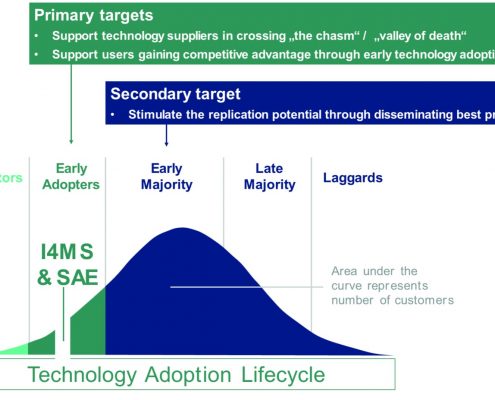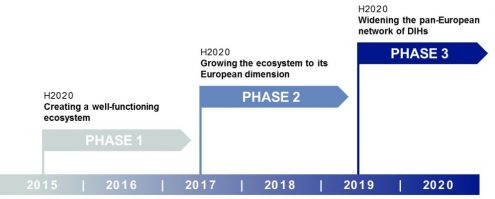The Smart Anything Everywhere (SAE) initiative
Smart Anything Everywhere: enhancing the digital transformation of the European industry through Digital Innovation Hubs
The goal of Smart Anything Everywhere (SAE) is to let SMEs, start-ups and mid-caps enhance their products and services through the inclusion of innovative digital technologies. DIHs will bring user companies (with a need to invest in digital technologies) in contact with supply companies that have suitable ICT products that address the needs of the users. They will get the opportunity to do a focused application experiment where the novel product or service is developed. This creates a win-win situation for all actors: the user company can evaluate whether this innovative product brings benefit to its business. The supply company has an early customer and can improve its offering based on this experience. The DIH has grown its ecosystem, and can support both companies to nurture their innovations further.
The ultimate goal of the application experiments is on the one hand to help foster competitiveness of in particular SMEs and mid-caps, and on the other hand to establish fully functional ecosystems of DIHs that can also provide services beyond technical advice such as business consulting and training.
The two phases of the SAE initiative have been dedicated to the creation of well-functioning ecosystems around regional DIHs in four technology areas:
- Cyber-physical and embedded systems: the goal is to help businesses from any sector uplift the quality and performance of their products and services with innovative embedded ICT components and systems and to support eco-system building for promising platforms.
- Customised low energy computing powering CPS and the IoT: the aim is to help businesses to develop products for applications where high computing capacity at low energy consumption creates a competitive advantage and to support eco-system building for promising platforms.
- Advanced micro-electronics components and Smart System Integration: the target is to support the take-up of electronic components, sensors, smart objects and systems by providing i) access to advanced design and manufacturing for academia, research institutes and SMEs, and ii) rapid prototyping capabilities for SMEs.
- Organic and large area electronics: the goal is to help businesses in further maturing, innovating and validating their products with organic and large area electronics technologies by i) giving them access to mature and ready to use design and prototyping facilities, and by ii) performing application experiments driven by concrete user requirements and business cases. The European industry should therefore gain competitive advantages.
Phase 1: Creating a well-functioning ecosystem
The first phase of the Smart Anything Everywhere initiative started in 2015 under H2020. It was building on the successful experience of the TETRACOM and COLAE projects of FP7. The total funding of these projects was €32 million.
The 160 application experiments that were conducted both in FP7 and H2020 have involved 48 DIHS, 150 SMEs and mid-caps. They have created enormous economic and societal impact, which is shown in the success stories in this brochure.
H2020 brought a major improvement. Through using the new “Financial Support to Third Parties” scheme (the so-called “cascade funding”), companies can sign a light contract with one of the projects’ beneficiaries rather than entering into a direct and more complex contract with the European Commission.
Phase 2: Growing the ecosystem and its European dimension
The second phase of SAE started in autumn 2017 with 4 new Innovation Actions (IA) and one Coordination and Support Action (CSA) to support the existing and new DIHs into forming a coherent pan-European network of hubs with a total funding of approximately €26 million. Special focus is on reinforcing the role of the DIHs in offering all innovation services that companies need. Not only testing and experimentation, but also skills development and having access to finance. Furthermore, collaboration with nationally/regionally funded DIHs is highly encouraged to be able to cover the whole of Europe.
The CSA, Smart4Europe, has an important role to play in integrating new DIHs in the existing network. They are organising networking events e.g. back to back to relevant world class events such as the Hannover Messe. Through these projects, a new set of more than 120 application experiments is foreseen, involving 40 new DIHs and 120 SMEs. They all have a cross-border dimension to foster collaboration on European level. In addition, this new phase also reflects the evolution of technology since the start of the initiative.
Skilling SMEs in digitising their business
A major role DIHs have to play is to deepen the understanding of the decision makers in SMEs, start-ups and mid-caps about which opportunities the digitisation provides for their company. This goes clearly beyond just technology transfer or offering digital services in an affordable manner. DIHs should provide the relevant staff in companies with the skills to use digital technology in order to improve their way of working and to digitise their products and services, processes and business models. The target is that at least 10-20% of the efforts in application experiments are devoted to skills development.
Further supporting SMEs and mid-caps
The total EU funding of Phase 2 is €26 million, of which about 60% will be spent to directly support SMEs and midcaps, either as direct funding or as services by DIHs. About 50% of the total funding will be allocated through 15 open calls in 2018-2020.
The presence of large industrial players in SAE will ultimately help SMEs and mid-caps, as establishing a customer relationship with such big players as reference will boost their business. The existing marketplaces will also be further enriched with new service offers and a new marketplace for additive manufacturing services will be established. Furthermore, the DIHs should attract investors to support business development of SMEs and midcap actors in successful application experiments.
Phase 3: Consolidating collaboration and widening the pan-European network of DIHs
In 2019 there will be a H2020 call for Smart Anything Every-where projects in the focus area „Digitising and transforming European industry and services“. 64M€ will be available for Innovation Actions stimulating the uptake of advanced digital technologies by European industry – especially SMEs and mid-caps – in products that include innovative electronic components, software and systems, especially in sectors where digital technologies are underexploited.
The areas addressed are:
Area 1. Cyber-physical and embedded systems: the goal is to help businesses from any sector uplift the quality and performance of their products and services by including (semi)-autonomy, paying special attention to security and privacy and to the collaboration between humans and machines.
Area 2. Customised low energy computing powering CPS and the IoT: the goal is to help businesses who are developing products for situations where high computing capacity and low energy would be a competitive advantage.
Area 3. Flexible and Wearable Electronics: the goal is to help businesses in further maturing, innovating and validating their products with thin, organic and large area electronics technologies, including wearable, portable and embedded objects. Focus is on i) access to design, technology and prototyping which are ready to use, and ii) application experiments driven by concrete user requirements and business cases.
Area 4. Widening Digital Innovation Hubs: it addresses all three technology areas mentioned above and the technologies addressed in I4MS. It calls for Digital Innovation Hubs in industrial regions which are so far underrepresented in Smart Anything Everywhere and I4MS, and builds upon a mentoring programme developed by I4MS and Smart Factories in new EU Member States. These hubs should strongly collaborate with other Innovation Actions funded under SAE and I4MS, e.g. through joint highly innovative cross-border experiments.
These new projects should contribute heavily to meet the goal of the Digitising European Industry Strategy (DEI) to have at least one DIH in every region by 2020. In the context of the Smart Factories project 30 organisations were selected at the end of 2017 to study the feasibility of becoming a Digital Innovation Hub that serves the needs of their region. Area 4 will be the opportunity for the coached hubs to become an integral part of the EU ecosystem of DIHs.
All in all, the European Commission plans to continue investing €100 million per year until 2020 in fostering DIHs as a main pillar of its Digitising European Industry strategy. Apart from SAE, calls for DIHs are launched for other related initiatives such as Innovation for Manufacturing SMEs (I4MS) (2020), for Photonics technologies (2020), for Robotics technologies (2018), for Big Data (2020) and for their overall coordination (2019).



